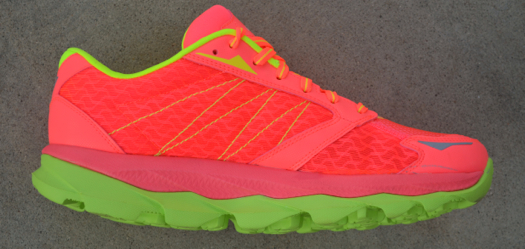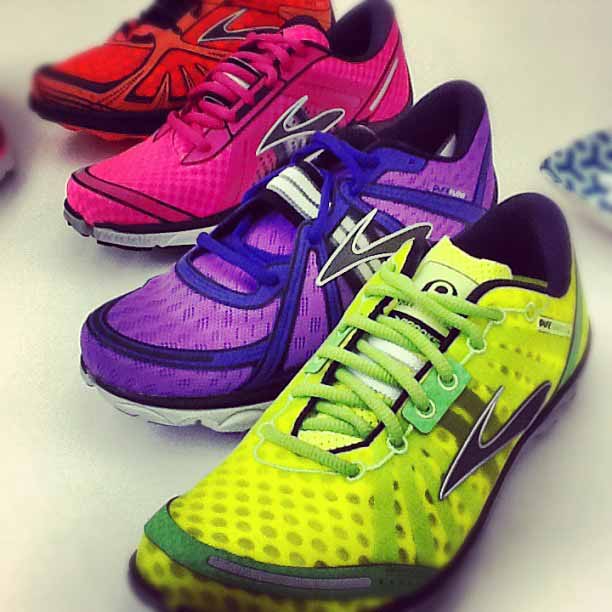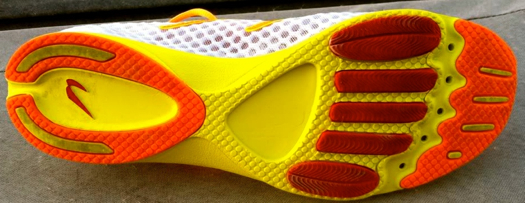Gettin’ Fancy With Specialized Running Shoes
 We’re getting fancy with our running shoes today! Though running shoes used to be a pretty standard setup (soles, upper, laces — voila! Go run!), a lot of niche markets have popped up within running in recent years. Today, if you go to your local running shop, you’ll find a variety of categories to cater to a variety of runners.
We’re getting fancy with our running shoes today! Though running shoes used to be a pretty standard setup (soles, upper, laces — voila! Go run!), a lot of niche markets have popped up within running in recent years. Today, if you go to your local running shop, you’ll find a variety of categories to cater to a variety of runners.
Minimalist Running Shoes
In his popular 2009 book, Born to Run, Christopher McDougall made a case for “natural running,” or running without footwear. Running shoes, he argued, impede the natural movement of the body, causing injuries. McDougall’s claims set off a huge demand for running shoes that mimicked the feel of running barefoot while still providing protection from rocks, sticks and debris.

The bare-bones Altra Superior boasts their patented Zero Drop sole and light mesh upper.
Buy them if: You are already running in something with a low heel-toe drop (see my last article about this) and regularly perform exercises to strengthen your feet and legs. Going from a traditional shoe to minimalist running overnight is a surefire recipe for injury. Competitor Running provides a great plan for transitioning to minimalist footwear.
Skip if: You don’t have the time, patience or desire to do the extra work the shoes require. In addition to strength work, minimalist running may require you to change your running technique, requiring lots of time and patience as you adjust to the new gait.
Maximalist Running Shoes
Of course, we knew the momentum from the minimalist movement would eventually swing the other way. Today, “maximalist” is the buzzword. The shoes are exactly what they sound like — big shoes with big cushioning (think of them as the Texas of the United States of Running). In spite of their clunky look, many maximalist shoes are incredibly lightweight and are designed with a rocker bottom for efficient movement.

Skechers GORun Ultra shows off a mega cushiony ride and rocker sole.
Buy them if: You log a lot of miles on the road or trail. The extra cushioning will be appreciated during long hours of pounding.
Skip if: You spend a lot of time on the treadmill. Most treadmills already have a lot of shock absorption, so maximalist shoes aren’t necessary.
Lightweight Running Shoes
Lightweight shoes are a byproduct of the minimalist movement: although many runners loved the idea of running in bare-bones footwear, their legs didn’t share the warm-fuzzy feeling. Injury rates jumped in new minimalist runners, sending manufacturers to find a satisfactory middle ground for those who wanted a minimalist feel with traditional support. Many lightweight shoes weigh in around four to eight ounces, compared to traditional shoes, which average 10 ounces or more.

The shoes in the PureProject line from Brooks are as bright and fun as they are quality.
Buy them if: You have a need for speed. Lighter shoes are designed for fast-paced training and racing efforts.
Skip if: You need extra support. Most lightweight shoes fall in the neutral category, meaning they are for runners who do not pronate. Though several lightweight shoes have been developed in the stability category (like the Mizuno Wave Paradox) they don’t always compare to the stability and protection you’d get from a more traditional shoe.
“Stride Correcting” Running Shoes
Minimalist shoes encourage a runner to use an efficient midfoot or forefoot stride by removing the cushioning in the heel — therefore, if they heel strike, it hurts. Other shoes, like those from Newton, encourage a midfoot strike through the use of elevated “actuator lugs” under the ball of the foot.
Buy if: You’re not a fan of minimalist shoes but still strive for a midfoot strike. Note: it’s not an overnight fix. Like minimalist shoes, Newtons take time and patience to transition without injury.
Skip if: You’re a trail runner. Rocks and sticks get stuck in the lugs easily, requiring you to stop frequently when you’d rather kick up some dirt.
Trail Running Shoes
The grizzly-bear version of running needs a grizzly-bear version of running shoes. If you’re taking to the trails on a regular basis, an investment in a pair of trail-specific shoes is a wise one.
The soles of trail shoes are a bit wider to provide stability on uneven surfaces, reducing the likelihood of you rolling an ankle on rocks or tree roots along the trail. You’ll also notice trail shoes have “teeth” along the bottom, allowing for better traction, and a rubber toe guard to prevent stubbing roots or rocks. Finally, the upper is made of more durable materials to withstand any conditions you encounter.
Buy if: Obviously, if you’re a trail runner, you’ll want a pair of trail shoes. But you may be surprised to learn a large number of obstacle races (think Spartan Race or Tough Mudder) recommend you wear trail shoes as well.
Skip if: You’re a city slicker who stays on the sidewalk. Though you certainly can wear trail shoes if you wish, the weight and thick uppers of such shoes are overkill.
Track Running Shoes
If you could use a pickup line on a shoe, it’d be track spikes. Considered the “sexy” shoes of running, track spikes are designed for speed. They are featherweight, airy and form-fitting (ooh-la-la!). On the thin sole, you’ll find a series of metal or rubber spikes designed to help improve traction as you round the curves of the track or surge past competitors.

The soles on the Asics Hyper-Rocketgirl. Even the name makes you want to do wind sprints.
Buy if: You’re serious about speed. Track and Field isn’t just for high school students anymore — check out USA Track & Field Masters to see if there’s an event near you. It can be a fun way to change up your routine.
Skip if: You only do occasional speedwork on the oval. Such specialized shoes aren’t worth the cash for casual runners, especially when your traditional shoes will suffice.
Do you enjoy getting fancy with your running shoes or take a more traditional route? —Susan

